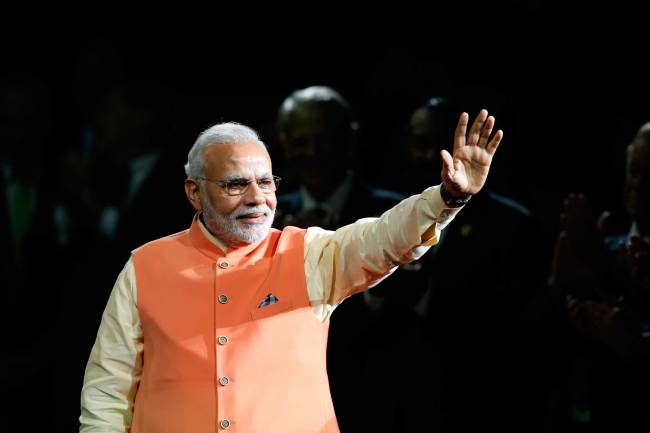With reforms, Indian economy becomes more open to investment, trade
By Joel LeePublished : Jan. 7, 2019 - 21:16
Under Prime Minister Narendra Modi’s externally focused economic drive, India jumped 23 spots on the World Bank’s 2018 Ease of Doing Business ranking to No. 77, according to the Indian Embassy in Seoul.
The rapid rise follows 2017’s upward move of 30 spots, placing India on near course to enter the world’s top 50 economies in terms of ease of doing business.
“That’s remarkable progress. It sets India apart from other countries in the region,” according to Long Island University economics professor Panos Mourdoukoutas.
The rapid rise follows 2017’s upward move of 30 spots, placing India on near course to enter the world’s top 50 economies in terms of ease of doing business.
“That’s remarkable progress. It sets India apart from other countries in the region,” according to Long Island University economics professor Panos Mourdoukoutas.

The Ease of Doing Business score measures the impact of government regulations on starting and operating a business, including the number of steps required to launch or terminate a business, deal with construction permits or obtain electricity.
The improvement over the last four years is the culmination of the efforts of the Department of Industrial Policy and Promotion and various departments at central, state and municipal levels, according to the Economic Times, an English-language daily in India.
“These dramatic improvements have resulted from the dedication of Mumbai and Delhi’s customs, shipping, ports and municipal corporations,” it said, “who have painstakingly worked on business process reengineering, online single-window systems and infrastructure improvements since 2015.”
To enter the top 50, India has attracted more than $60 billion annually in foreign investment under the “Make in India” initiative, aimed at turning the country into a global manufacturing hub.
Meanwhile, the Indian economy has risen in another global ranking, the World Economic Forum’s competitiveness report, where it stands at No. 40 out of 137 countries studied. That’s a record for India, and a sharp rise from its No. 71 position three years ago.
“Last four years has shown that India can excel when a strong political leadership is committed to reforms, and a group of dedicated and hardworking officials is given the right support,” the newspaper said in November.
Vijay Govindarajan Coxe, a distinguished professor at the Tuck School of Business at Dartmouth, said India’s strong economic performance can be attributed to deregulation under the ruling Bharatiya Janata Party, with the world’s perception of India concerning business changing steadily.
The ongoing trade war between Washington and Beijing has also made India an attractive choice for foreign investors.
“Improvements in the ease of doing business, the rise in competitiveness and increasing foreign capital flows have all helped place India among the world’s (four) fastest-growing economies,” he said, citing the International Monetary Fund’s World Economic Outlook, which says India’s economy grew 7.3 percent last year and will expand 7.4 percent this year, putting it ahead of China in terms of rapid growth.
But the scholar also conceded that “India’s rise in the world economy has yet to touch the masses. In fact, the average Indian is worse off under Modi.”
Union Minister for Commerce and Industry Suresh Prabhu forecast that the Indian economy will quadruple to $10 trillion by 2035, riding on business-friendly policies, structural reforms and transparency in governance. He added that the government was prepared to “achieve the number in an aggressive way,” emphasizing the importance of private sector-led growth.
In particular, India’s information technology spending is projected to reach nearly $90 billion this year, a 6.7 percent on-year increase, according to recent estimates by global consulting firm Gartner. Indian IT services and devices and enterprise software are the major segments driving the spending, with the software as a service market being the key driver of all software segments.
“India is currently a growing market and Samsung considers it a very important one,” said Park Sang-il, a principal product designer at Samsung Electronics’ mobile communications division, adding that there was a lot of collaboration with Indian designers working in Korea.
With Samsung targeting young customers and especially millennials, India’s smartphone market is seeing fierce competition between the South Korean technology giant and its rising rival Xiaomi from China, with the latter overtaking Samsung in market share in the third quarter of last year.
“Betting big on India, Samsung will also conduct 5G field trials in New Delhi in the first half of this year, and is said to be working closely with the Department of Telecommunications,” according to the embassy. “Samsung will work with Academia Telcos, India’s official 5G forum, and other stakeholders, to conduct these trials.”
By Joel Lee (joel@heraldcorp.com)








![[Graphic News] More Koreans say they plan long-distance trips this year](http://res.heraldm.com/phpwas/restmb_idxmake.php?idx=644&simg=/content/image/2024/04/17/20240417050828_0.gif&u=)
![[KH Explains] Hyundai's full hybrid edge to pay off amid slow transition to pure EVs](http://res.heraldm.com/phpwas/restmb_idxmake.php?idx=644&simg=/content/image/2024/04/18/20240418050645_0.jpg&u=20240419100350)





![[From the Scene] Monks, Buddhists hail return of remains of Buddhas](http://res.heraldm.com/phpwas/restmb_idxmake.php?idx=652&simg=/content/image/2024/04/19/20240419050617_0.jpg&u=20240419175937)

![[KH Explains] Hyundai's full hybrid edge to pay off amid slow transition to pure EVs](http://res.heraldm.com/phpwas/restmb_idxmake.php?idx=652&simg=/content/image/2024/04/18/20240418050645_0.jpg&u=20240419100350)

![[Today’s K-pop] Illit drops debut single remix](http://res.heraldm.com/phpwas/restmb_idxmake.php?idx=642&simg=/content/image/2024/04/19/20240419050612_0.jpg&u=)